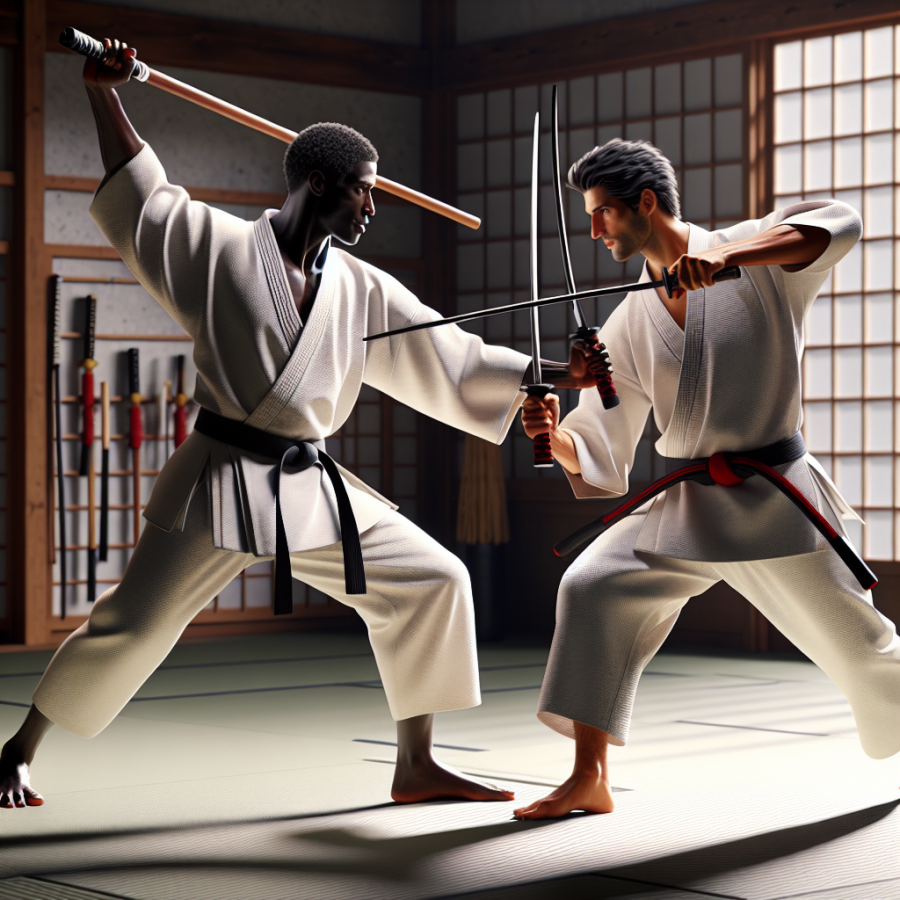Unearthing the Roots of Okinawan Kobudō
Okinawan Kobudō, the intriguing weapons-based martial arts system from the Ryukyu Islands, encompasses a rich tapestry of history and tradition. Its name signifies the ways of the ancient martial arts, "Ko" meaning old, "Bu" meaning martial, and "Dō" reflecting the way or path. Despite its historic connotations, Kobudō is a vibrant practice that survives and thrives in contemporary martial arts culture, both within Okinawa and worldwide.
The origins of Kobudō can be traced back to the unique geographical and political circumstances of the Ryukyu Kingdom, which necessitated the development of a distinctive form of self-defense. Okinawa, being a hub of trade among Asian countries, was exposed to various fighting systems. This exposure significantly influenced the evolution of the indigenous fighting techniques of the region.
It is widely believed that the genesis of Kobudō coincided with periods when the local populace was forbidden from bearing arms. These bans were a direct result of the Japanese invasion and subsequent efforts to maintain control over the islands. As a result, the Okinawans turned to everyday tools as improvised weapons to defend themselves and their communities. Consequently, farming implements, fishing equipment, and household items were transformed into lethal instruments.
Agricultural tools played a seminal role in the development of Kobudō's armament. The "Nunchaku," perhaps the most renowned Kobudō weapon, often thought of in connection with the martial artist Bruce Lee, was originally a rice flail used to thresh and separate grains. Meanwhile, the "Kama," a weapon resembling a sickle, began as a farming implement for cutting grass and reaping crops. Similarly, the "Bo," a six-foot staff, has roots as a carrying pole. Each of these tools allowed Okinawans to practice martial skills under the guise of daily work, leading to a distinctive martial art that was deeply woven into the functionality of their lifestyles.
Masters and practitioners who have shaped Kobudō over time have also impacted its propagation and divergence of styles. Notable figures like Taira Shinken and Matayoshi Shinpo are credited with formalizing many aspects that epitomize contemporary Kobudō practice. These pioneers codified techniques, kata (formal exercises), and teaching methods, ensuring that the knowledge passed through generations remained intact.
Read also:
The Graceful World of Artistic Cycling Revealed
Expanding on the topic of Okinawan Kobudō, an ancient martial arts tradition, the professional blog section will delve into various facets of this intriguing art form.
### Historical Context of Okinawan Kobudō
Okinawan Kobudō is intrinsically linked to the history of the Ryukyu Islands, now known as Okinawa. This martial art evolved from the necessity of defending oneself using agricultural implements and fishing tools, as the carrying of weapons was often forbidden under various regimes. Kobudō developed secretly, blending with the native fighting techniques and Chinese martial arts influences that traveled to the islands through trade.
### The Weapons of Kobudō
Central to Kobudō are the weapons, each with its distinctive history and technique. Some of the primary kobudō weapons include the bō (a long staff), sai (a three-pronged truncheon), tonfa (handled club), nunchaku (flail), kama (sickle), and eku (oar). Mastery of these weapons is seen as both a physical and spiritual journey, with each weapon offering unique challenges and philosophical insights.
### Training and Techniques
Training in Kobudō focuses on fluidity, control, and the application of force. Practitioners work on kata (forms) which are detailed choreographed patterns of movements. These katas teach important principles such as maai (combat distancing), kime (focus), and zanshin (awareness). Sparring (kumite) with these weapons requires precision, as the margin for error can be small due to the potential lethality of the techniques.
### The Philosophy of Kobudō
At its heart, Kobudō is not solely concerned with combat effectiveness but is also a path towards self-improvement and spiritual growth. The practice of Kobudō is as much about character development as it is about self-defense. Patience, perseverance, respect, and humility are all key tenets that students are expected to embody.
### Modern Practice and Preservation
Today, Okinawan Kobudō is practiced worldwide, both in traditional dojos and through modern martial arts schools. Efforts to preserve and promote this martial art include tournaments, demonstrations, and the establishment of various organizations dedicated to maintaining the integrity and teachings of Kobudō. There's a particular emphasis on respecting the cultural heritage of the art while adapting its teachings to be relevant in the modern world.
Mastering the Weapons and Techniques of Okinawan Traditional Martial Arts
Certainly! Let's delve into the weapons and techniques of Okinawan Traditional Martial Arts, focusing particularly on Kobudo, which is the term for the weapon systems of Okinawan martial arts.
**The Rich Arsenal of Okinawan Kobudō**
At the heart of Okinawan Kobudō lies an array of weapons, each with its unique history and application. The weapons were often derived from tools used in everyday life. What is fascinating is how the Okinawans transformed these tools into effective instruments for self-defense. The primary Kobudō weapons include the Bo, Sai, Tonfa, Nunchaku, and Kama, among others.
The Bo is a long staff usually about six feet in length. Mastery of the Bo involves learning a combination of strikes, blocks, spins, and sweeps. It can be utilized for both long and short-range combat, depending on the practitioner's grip and the techniques employed. The primary goal is to keep an opponent at bay while delivering powerful strikes and blocks.
The Sai, which resembles a short sword but with two prongs jutting out from the handle, is a unique weapon used in pairs. Practitioners learn to trap an opponent’s weapon between the prongs and employ a variety of techniques for thrusting, striking, and blocking with both the point and the sides of the weapon.
Tonfa originated from a handle used on a millstone and is often used in pairs. It can be held in several ways, allowing for a wide range of blocking and striking techniques. The unique design provides an extension for the forearm, increasing the defensive and offensive capabilities of the practitioner.
Nunchaku, made famous by martial arts icon Bruce Lee, is composed of two sticks connected by a short chain or rope. Mastery of the Nunchaku requires dexterity, coordination, and timing. Techniques include circular and figure-eight patterns to build momentum for strikes, as well as sudden directional changes for defensive maneuvers.
The Kama is a sickle and in Kobudō generally used in pairs. Like other kobudo weapons, it was originally an agricultural tool repurposed for self-defense. Practitioners of Kobudō use it for slicing, hooking, and trapping, with fluid movements that can be deceptive to an opponent.
**Techniques Cementing the Essence of Kobudō**
Kobudō techniques emphasize fluidity, control, and the ability to transition seamlessly between offensive and defensive positions.




